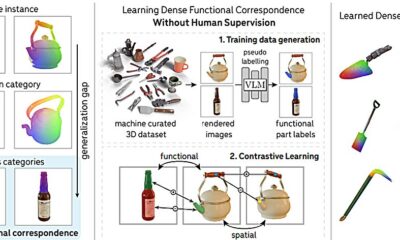Tech
Is AI ready for the courtroom? New framework tackles the technology’s biggest weaknesses

For over a decade, computer scientist Randy Goebel and his colleagues in Japan have been using a tried-and-true method from his field to advance artificial intelligence in the world of law: a yearly competition.
Drawing on example legal cases taken from the Japanese bar exam, contestants must use an AI system that can retrieve statutes relevant to the cases, and, more crucially, make a decision: did the defendants in the cases break the law, or not?
It’s this yes/no answer that AI struggles with the most, says Goebel—and it raises questions of whether AI systems can be ethically and effectively deployed by lawyers, judges and other legal professionals who face giant dockets and narrow time windows to deliver justice.
The contest has provided the foundation for a new paper in which Goebel and his co-authors outline the types of reasoning AI must use to “think” like lawyers and judges, and describe a framework for imbuing large language models (LLMs) with legal reasoning.
The paper is published in the journal Computer Law & Security Review.
“The mandate is to understand legal reasoning, but the passion and the value to society is to improve judicial decision-making,” Goebel says.
The need for these kinds of tools has been especially critical since the Supreme Court of Canada’s Jordan decision, Goebel says. That decision shortened the length of time prosecutors have to bring a case to trial, and it has resulted in cases as severe as sexual assault and fraud being thrown out of court.
“It’s a very good motivation to say, ‘Let’s enable the judicial system to be faster, more effective and more efficient,'” Goebel says.
Making machines ‘think’ like lawyers
The paper highlights three types of reasoning AI tools must possess to think like legal professionals: case-based, rule-based and abductive reasoning.
Some AI systems, such as LLMs, have proven adept at case-based reasoning, which requires legal experts to examine previous court cases and determine how laws were applied in the past to draw parallels to the current case in question.
Rule-based reasoning, which involves applying written laws to unique legal cases, can also be completed to some extent by AI tools.
But where AI tools struggle the most is with abductive reasoning, a type of logical inference that involves stringing together a plausible series of events that could explain, for example, why a defendant is not guilty of a crime. (Did the man with the knife in his hand stab the victim? Or did a gust of wind blow the knife into his hand?)
“Not surprisingly, abductive reasoning can’t be done by modern large language models, because they don’t reason,” Goebel says. “They’re like your friend who has read every page of Encyclopedia Britannica, who has an opinion on everything but knows nothing about how the logic fits together.”
Combined with their tendency to “hallucinate,” or invent “facts” wholesale, generic LLMs applied to the legal field are at best unreliable and, at worst, potentially career-ending for lawyers.
The important challenge for AI scientists is whether they can develop a reasoning framework that works in conjunction with generic LLMs to focus on accuracy and contextual relevance in legal reasoning, Goebel says.
No one-size-fits-all AI tool
When will we have AI tools that can cut the work of lawyers and judges in half? Perhaps not any time soon.
Goebel says a key takeaway from the competition, and one that is also outlined in the paper, is that using computer programs to aid legal decision-making is relatively new, and there is still a lot of work to be done.
Goebel foresees many separate AI tools employed for different types of legal tasks, rather than a single “godlike” LLM.
Claims made by some in the AI industry that humanity is on the cusp of creating an AI tool that can render “perfect” judicial decisions and legal arguments are absurd, Goebel says.
“Every judge I’ve spoken to has acknowledged there is no such thing as perfect judgment,” he says. “The question is really, ‘How do we determine whether the current technologies provide more value than harm?'”
More information:
Ha Thanh Nguyen et al, LLMs for legal reasoning: A unified framework and future perspectives, Computer Law & Security Review (2025). DOI: 10.1016/j.clsr.2025.106165
Citation:
Is AI ready for the courtroom? New framework tackles the technology’s biggest weaknesses (2025, October 28)
retrieved 28 October 2025
from https://techxplore.com/news/2025-10-ai-ready-courtroom-framework-tackles.html
This document is subject to copyright. Apart from any fair dealing for the purpose of private study or research, no
part may be reproduced without the written permission. The content is provided for information purposes only.
Tech
How digital technologies can support a circular economy

The role of digital technologies, such as IoT, 3D printing, and digital platforms, holds significant potential for supporting a circular economy. However, digital technologies are not a magic fix that can instantly change how physical resources are used and produced to prevent waste and promote a circular economy.
In her doctoral thesis, Ida Eyi Heathcote-Fumador explores digitally mediated circular practices within ecosystems to understand the human–material interactions involved in enabling a digitally mediated circular economy. Heathcote-Fumador will defend the thesis on November 5.
Circular economy focuses on managing the use and creation of physical resources, products, residual materials, and by-products to prevent them from ending up in landfills as waste, while ensuring that organic materials safely return to the environment.
What challenges do you focus on in your research?
Material resources and their sustainable management are central to the circular economy, while digital technologies are often seen as more intangible, flexible, and having multiple functions. When examining the role of digital technologies, we often overlook the material characteristics that shape these technologies, as well as the human activities involved in ensuring that technological and material configurations align with the principles of sustainable material management.
How do you address the problem?
I studied two ecosystems, or groups of organizations working together: one in Ghana, Africa, and the other in Europe, specifically Sweden and Portugal. Both focused on using digital technologies to support the sustainable recovery of waste from the environment.
Through interviews, observations, and document analysis, I examined how physical materials, digital technologies, and human activities influence each other to create digitally mediated circular practices. I used a human-material tuning approach to understand the mutual roles of materials, digital technologies, and human actions in establishing circular practices.
What are the main findings?
I developed a model showing that the circular principles of resource care are central to activities leading to the emergence of digitally mediated circular practices. Human actions involve the collective imagination of sustainable futures for production and consumption, the prospecting of suitable materials and digital technologies, and their shaping to realize these visions. This shaping process, referred to as tuning—a term first introduced by Andrew Pickering (1993)—is akin to adjusting a radio to obtain a preferred signal.
For instance, the organizations I studied shared a strong commitment to reducing environmental waste by converting it into new products with the help of digital technologies. They identified discarded materials such as fishing nets and selected technologies like 3D printing to transform these wastes into new products.
However, because 3D printers are typically optimized for virgin materials, the process requires extensive experimentation to adapt the technology to recycled inputs. This perseverance, driven by care for both the material and the environment, enabled the successful realization of digitally mediated circular practices.
What do you hope your research will lead to?
My research aims to encourage both scholars and practitioners to consider the material and human activities of the circular economy when examining how digital technologies enable it. Circularity is based on specific principles, with materials at its center. Recognizing and documenting their influence can enhance our overall understanding of how material, digital, and human components interconnect, shaping digitally mediated circular practices. This comprehensive recognition will result in solutions that effectively promote a circular economy.
More information:
Digitally Mediated Circular Economy Practices in Ecosystems : A Human-Material Tuning Practice Perspective. research.chalmers.se/en/publication/548860
Citation:
How digital technologies can support a circular economy (2025, October 28)
retrieved 28 October 2025
from https://techxplore.com/news/2025-10-digital-technologies-circular-economy.html
This document is subject to copyright. Apart from any fair dealing for the purpose of private study or research, no
part may be reproduced without the written permission. The content is provided for information purposes only.
Tech
OpenAI says a million ChatGPT users talk about suicide

Data from ChatGPT-maker OpenAI suggest that more than a million of the people using its generative AI chatbot have shown interest in suicide.
In a blog post published on Monday, the AI company estimated that approximately 0.15% of users have “conversations that include explicit indicators of potential suicidal planning or intent.”
With OpenAI reporting more than 800 million people use ChatGPT every week, this translates to about 1.2 million people.
The company also estimates that approximately 0.07% of active weekly users show possible signs of mental health emergencies related to psychosis or mania—meaning slightly fewer than 600,000 people.
The issue came to the fore after California teenager Adam Raine died by suicide earlier this year. His parents filed a lawsuit claiming ChatGPT provided him with specific advice on how to kill himself.
OpenAI has since increased parental controls for ChatGPT and introduced other guardrails, including expanded access to crisis hotlines, automatic rerouting of sensitive conversations to safer models, and gentle reminders for users to take breaks during extended sessions.
OpenAI said it has also updated its ChatGPT chatbot to better recognize and respond to users experiencing mental health emergencies, and is working with more than 170 mental health professionals to significantly reduce problematic responses.
© 2025 AFP
Citation:
OpenAI says a million ChatGPT users talk about suicide (2025, October 28)
retrieved 28 October 2025
from https://techxplore.com/news/2025-10-openai-million-chatgpt-users-suicide.html
This document is subject to copyright. Apart from any fair dealing for the purpose of private study or research, no
part may be reproduced without the written permission. The content is provided for information purposes only.
Tech
Novel textile can adjust its aerodynamic properties on demand

Imagine a road cyclist or downhill skier whose clothing adapts to their wind speed, allowing them to shave time just by pulling or stretching the fabric.
Such cutting-edge textiles are within reach, thanks to researchers at the Harvard John A. Paulson School of Engineering and Applied Sciences (SEAS). Led by SEAS mechanical engineering graduate student David Farrell, a study published in Advanced Materials describes a new type of textile that uses dimpling to adjust its aerodynamic properties while worn on the body. The research has the potential to change not only high-speed sports, but also industries like aerospace, maritime, and civil engineering.
The research is a collaboration between the labs of Katia Bertoldi, the William and Ami Kuan Danoff Professor of Applied Mechanics, and Conor J. Walsh, the Paul A. Maeder Professor of Engineering and Applied Sciences.
On-demand golf ball dimples
Farrell, whose research interests lie at the intersection of fluid dynamics and artificially engineered materials, or metamaterials, led to the creation of a unique textile that forms dimples on its surface when stretched, even when tightly fitted around a person’s body. The fabrics utilize the same aerodynamic principles as a golf ball, whose dimpled surface causes a ball to fly farther by using turbulence to reduce drag. Because the fabric is soft and elastic, it can move and stretch to change the size and shape of the dimples on demand.
Adjusting dimple sizes can make the fabric perform better in certain wind speeds by reducing drag by up to 20%, according to the researchers’ experiments using a wind tunnel.
“By performing 3,000 simulations, we were able to explore thousands of dimpling patterns,” Farrell said. “We were able to tune how big the dimple is, as well as its form. When we put these patterns back in the wind tunnel, we find that certain patterns and dimples are optimized for specific wind-speed regions.”
Farrell and team used a laser cutter and heat press to create a dual-toned fabric made of a stiffer black woven material, similar to a backpack strap, and a gray, softer knit that’s flexible and comfortable. Using a two-step manufacturing process, they cut patterns into the woven fabric and sealed it together with the knit layer to form a textile composite. Experimenting with multiple flat samples patterned in lattices like squares and hexagons, they systematically explored how different tessellations affect the mechanical response of each textile material.
Lattice pattern
The textile composite’s on-demand dimpling is the result of a lattice pattern that Bertoldi and others have previously explored for its unusual properties. Stretch a traditional textile onto the body, and it will smooth out and tighten. “Our textile composite breaks that rule,” Farrell explained. “The unique lattice pattern allows the textile to expand around the arm rather than clamp down.
“We’re using this unique property that [Bertoldi] and others have explored for the last 10 years in metamaterials, and we’re putting it into wearables in a way that no one’s really seen before,” Farrell said.
More information:
David T. Farrell et al, Programmable Surface Dimpling of Textile Metamaterials for Aerodynamic Control, Advanced Materials (2025). DOI: 10.1002/adma.202505817
Citation:
Novel textile can adjust its aerodynamic properties on demand (2025, October 28)
retrieved 28 October 2025
from https://techxplore.com/news/2025-10-textile-adjust-aerodynamic-properties-demand.html
This document is subject to copyright. Apart from any fair dealing for the purpose of private study or research, no
part may be reproduced without the written permission. The content is provided for information purposes only.
-

 Fashion1 week ago
Fashion1 week agoChinese woman charged over gold theft at Paris Natural History Museum
-

 Entertainment1 week ago
Entertainment1 week agoJohn Grisham unveils his first-ever mystery, “The Widow”
-

 Tech1 week ago
Tech1 week agoThis Smart Warming Mug Is Marked Down by $60
-

 Fashion1 week ago
Fashion1 week agoeBay UK seller fee removal sends revenue down but profits rise
-

 Tech1 week ago
Tech1 week agoEaster Island’s Moai Statues May Have Walked to Where They Now Stand
-

 Fashion1 week ago
Fashion1 week agoThe North Face and Cecilie Bahnsen launch second collaboration
-

 Tech1 week ago
Tech1 week agoOpenAI has slipped shopping into ChatGPT users’ chats—here’s why that matters
-

 Tech1 week ago
Tech1 week agoAI model could boost robot intelligence via object recognition

















